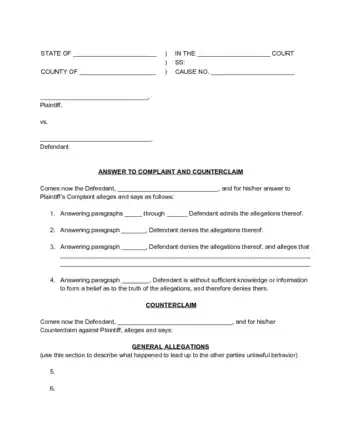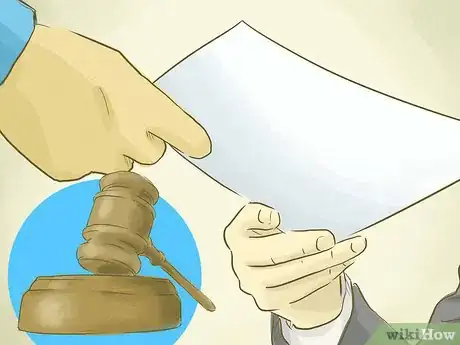This article was co-authored by Clinton M. Sandvick, JD, PhD. Clinton M. Sandvick worked as a civil litigator in California for over 7 years. He received his JD from the University of Wisconsin-Madison in 1998 and his PhD in American History from the University of Oregon in 2013.
wikiHow marks an article as reader-approved once it receives enough positive feedback. In this case, 85% of readers who voted found the article helpful, earning it our reader-approved status.
This article has been viewed 272,687 times.
When a plaintiff sues you for money or the return of property, you can defend yourself in civil court. You have another legal remedy if the plaintiff is actually at fault. You can counter sue. Countersuing involves suing the plaintiff while his or her case is still pending against you by filing a “counterclaim.”
Steps
Sample Answer and Counterclaim
Understanding a Counterclaim
-
1Learn the purpose of a counterclaim. A counterclaim is a claim against the party that originally instituted an action against you. In some states, a counterclaim is called a “cross-complaint.” Under the federal rules, you can file a counterclaim against your opponent for any claim that you have against them, whether or not the claim relates to the lawsuit filed against you. If the claim that you have against the opposing party arises from the same event or action for which they are suing you, you must file a counterclaim. You will otherwise waive your right to sue them in the future.
- For example, say someone with whom you were in a car accident decides to sue you. If you believe that the car accident was actually their fault, you must assert a counterclaim against them. You cannot sue them at a later date.
- The Federal Rules of Civil Procedure govern counterclaims in federal court.
- If the lawsuit is in state court, the state rules of civil procedure for your state probably govern the proceedings. However, most states have adopted rules that are very similar to the federal rules.
-
2Understand when to file a counterclaim. Under the Federal Rules of Civil Procedure, you usually have 21 days from the day you receive your summons and complaint to file your answer. [1] Read the summons and complaint carefully. Both state and federal courts offer standardized “answer to complaint” forms for the respective jurisdiction. These forms usually have space to introduce a counterclaim. You should file your counterclaim with the answer to complaint if possible.[2] If you need more time to file, you may file a motion with the court asking for more time.
- For instance, you can find instruction for the Southern District of New York Federal Court here and the form for the California state courts here.
- Though many states follow the Federal Rules of Civil Procedure, it’s not mandatory. Ensure you find out how much time you have to file in your state. Failing to file an answer or counterclaim on time may result in a default judgment hearing and potentially a default judgment against you.
- The court can grant your motion for “good cause,” which is left to the discretion of the judge who is handling your case.
- A lawyer is your best option for determining the validity of the counterclaims you wish to bring against the person suing you.[3]
Advertisement -
3File your counterclaim after you have answered the complaint only in situations where the counterclaim arises after the initial filing. Your counterclaim against the opposing party may not arise or become apparent to you until after you have already answered the complaint. In this case, the court may permit you to file a supplemental pleading asserting a counterclaim that matured after serving an earlier pleading.[4]
Preparing Your Countersuit
-
1Look up the elements of the action that you wish to use. Your counterclaim will require the specific statutes from your state’s civil code that you wish to use as grounds for your counterclaim. You can find this information by looking in your state’s civil code, searching online for common law principles, or calling the clerk of court to ask. You should also consider talking to and hiring an attorney. Correctly filing your counterclaim is very important to your case, because the opposing side could attempt to get it thrown out of court. Having an attorney write your counterclaim for you will insure that it appears in the correct format and contains all of the necessary elements.
- The opposing side can use statements you make in both your answer and counterclaim against you in ways you might not anticipate.[5] An attorney will not only file the counterclaim correctly but ensure the proper wording of all claims as well.
-
2Prepare a counterclaim form. Many states offer a standardized counterclaim form that you can use to file. You can also search online for examples of counterclaims that others have previously filed. If you are not using a form, make sure you identify the party and what you allege that they did wrong.
- Put the facts of the occurrence in your counterclaim. Be as specific as possible. Usually, you will number the allegations you have against the opposing party and include your facts that way.[6]
-
3File your counterclaim. Give the clerk of courts a copy of your complaint at the same location where the plaintiff filed the original complaint. You may file the counterclaim at the same time you file your answer.
- Make sure that you keep a copy of the counterclaim for you records.
-
4Pay the filing fee. The filing fee will vary depending on the court where the plaintiff filed the lawsuit. You can call ahead or look online to determine the fee for your specific court.
-
5Serve the opposing party’s attorney. Once you have filed your counterclaim, you need to give a copy of it to the opposing party. The party will have to file an answer the same way you did. If the opposing party is represented by counsel, you may serve a copy of the counterclaim to the opposing party’s counsel.
- You or your attorney can simply call the attorney for the opposing party and ask them if they will accept service for their client. If they say yes, there is no need to serve the opposing party.
-
6Serve an unrepresented opposing party. If the opposing party is unrepresented, you must serve the counterclaim by a different method. As a party to the lawsuit, you cannot personally serve the opposing party. You must confirm the appropriate ways to serve an answer and counterclaim under your state’s laws. Options include:
- Certified or first class mail. To serve by certified or first class mail, tell the clerk that you would like to serve this way, and pay a small fee, usually around $10. Remember, you cannot mail a copy of the counterclaim to the defendant yourself.
- Personal service. A personal service means that someone will hand a copy of the counterclaim to the opposing party in the suit. Usually, the sheriff’s department in the county where you file the counterclaim will personally serve the defendant for a small fee. When you file, tell the court that you want “sheriff service” and the clerk will facilitate the service.
- You can also hire a private “process server” from a legal services company, and that person will serve the opposing party.
Warnings
- This article is for information purposes only. Filing a counterclaim can be complicated. Do not hesitate to seek legal counsel.⧼thumbs_response⧽
References
- ↑ Federal Rules of Civil Procedure
- ↑ http://www.lawhelpnc.org/files/CF76DC62-D528-7183-3117-39472C017826/attachments/7B3ADFA8-5301-4312-B697-E6D2F9401206/consumer-instructions-to-answer-a-complaint.pdf
- ↑ http://www.lawhelpnc.org/files/CF76DC62-D528-7183-3117-39472C017826/attachments/7B3ADFA8-5301-4312-B697-E6D2F9401206/consumer-instructions-to-answer-a-complaint.pdf
- ↑ https://www.law.cornell.edu/rules/frcp/rule_13
- ↑ http://www.lawhelpnc.org/files/CF76DC62-D528-7183-3117-39472C017826/attachments/7B3ADFA8-5301-4312-B697-E6D2F9401206/consumer-instructions-to-answer-a-complaint.pdf
- ↑ http://www.lawhelpnc.org/files/CF76DC62-D528-7183-3117-39472C017826/attachments/7B3ADFA8-5301-4312-B697-E6D2F9401206/consumer-instructions-to-answer-a-complaint.pdf
About This Article
To counter sue someone, start by printing out the counterclaim form from your state court’s website. Then, complete the form with all the facts related to your claim, and be as clear as possible about your reasons for counter suing. Make sure to include the specific statues from your state’s civil code that give you grounds for your counterclaim. You may also want to consult an attorney to ensure that your counterclaim is formatted correctly, and that it contains all the necessary elements. For more information from our Legal co-author, including how to figure out when to file your counterclaim, read on!










































































